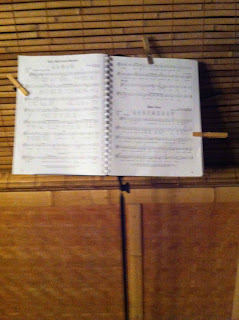Sept., 2012
Sunday we went to a picnic at Two Step in Honaunau, HI. As we were about to leave I noticed a lovely 30 something woman who had a large tattoo on her back - of a pair of scissors!
This grey scale drawing was almost like a photograph of the pair of scissors I use to cut fabric. It was about a foot long, the blades closed and correctly pointing down. For this reason, I felt safe asking her about her tattoo.
I began the conversation by asking if she liked to sew. Her answer, no she wasn't a sewer, was surprising. She said the reason she had this tattoo was because she thought that scissors were a beautiful shape and form. She said she collected scissors. Friends often give her scissors as gifts. I asked how she displayed her collection. She told me she kept them in a suitcase.
We discussed how scissors in Hawaii can quickly get rusty, and the various types of scissors. I told her about an expensive pair of scissors I bought specifically for flower arranging. The other day I got them out to use on flowers from the garden to make an arrangement, and found the blades were totally rusty.
I also told her that I have a beautiful Alaska Native beaded scissors case meant to be worn around your neck, that holds small scissors you might use for snipping yarn. She didn't seem to know about knitting. I asked her if she had the kind of thread and yarn cutter that is shaped like a rose that you wear as a necklace. The sharp blades are indented in the design allowing you to carry it on an airplane. She had never heard of that and didn't know people needed scissors on airplanes.
I began to realize that I, too, have a scissors collection. I have very expensive sharp, long scissors for cutting fabric, pinking shears, thread nippers, the round thread cutter, tiny scissors for a travel sewing kit, and several small scissors for knitting. I have a whole other collection of scissors for flower arranging, for crafts, and several clippers for the garden. Then there are my scissors used for cutting hair, and several different types of clippers for cutting fingernails and cuticles, and straight ones for trimming eyebrows.
The kitchen scissors are constantly in use. They are also the ones that gave me the stitches in my hand after I tried to use them to open a plastic package. I even have a pair of scissors on a Swiss Army knife kept in the car. There is a pair of blue scissors at my desk.
I don't know if I have enough scissors to fill a suitcase, but I wouldn't be keeping them there because I use them all the time.
The girl with the scissors tattoo, or: form vs. function.
This grey scale drawing was almost like a photograph of the pair of scissors I use to cut fabric. It was about a foot long, the blades closed and correctly pointing down. For this reason, I felt safe asking her about her tattoo.
I began the conversation by asking if she liked to sew. Her answer, no she wasn't a sewer, was surprising. She said the reason she had this tattoo was because she thought that scissors were a beautiful shape and form. She said she collected scissors. Friends often give her scissors as gifts. I asked how she displayed her collection. She told me she kept them in a suitcase.
We discussed how scissors in Hawaii can quickly get rusty, and the various types of scissors. I told her about an expensive pair of scissors I bought specifically for flower arranging. The other day I got them out to use on flowers from the garden to make an arrangement, and found the blades were totally rusty.
I also told her that I have a beautiful Alaska Native beaded scissors case meant to be worn around your neck, that holds small scissors you might use for snipping yarn. She didn't seem to know about knitting. I asked her if she had the kind of thread and yarn cutter that is shaped like a rose that you wear as a necklace. The sharp blades are indented in the design allowing you to carry it on an airplane. She had never heard of that and didn't know people needed scissors on airplanes.
I began to realize that I, too, have a scissors collection. I have very expensive sharp, long scissors for cutting fabric, pinking shears, thread nippers, the round thread cutter, tiny scissors for a travel sewing kit, and several small scissors for knitting. I have a whole other collection of scissors for flower arranging, for crafts, and several clippers for the garden. Then there are my scissors used for cutting hair, and several different types of clippers for cutting fingernails and cuticles, and straight ones for trimming eyebrows.
The kitchen scissors are constantly in use. They are also the ones that gave me the stitches in my hand after I tried to use them to open a plastic package. I even have a pair of scissors on a Swiss Army knife kept in the car. There is a pair of blue scissors at my desk.
I don't know if I have enough scissors to fill a suitcase, but I wouldn't be keeping them there because I use them all the time.
The girl with the scissors tattoo, or: form vs. function.









































